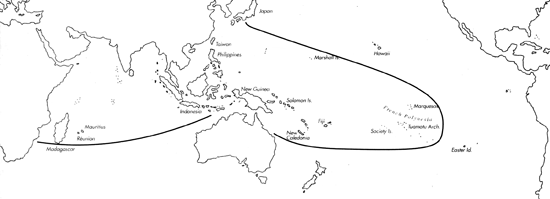
Skip Navigation Links
View access keys for this site.

Range: Indo-Pacific except for Hawaii.
Description: Moderately large to large, moderately solid to moderately heavy. Form gracianus (Pl. 61, Fig 6) moderately small to moderately large, moderately solid. Last whorl narrowly cylindrical to narrowly ovate, sometimes cylindrical to ovate; outline straight and parallel-sided to slightly convex; left side concave and right side straight at basal fourth. Aperture wider at base than near shoulder. Shoulder subangulate to rounded. Spire usually of moderate height, outline straight to slightly concave. Larval shell of 2.5-3 whorls, maximum diameter about 0.8 mm. First 2-5 postnuclear whorls tuberculate, sometimes weakly tuberculate. Teleoconch sutural ramps slightly concave to slightly convex, with 1 increasing to 3-4 spiral grooves in early whorls; late ramps with numerous spiral striae. Last whorl with fine, closely spaced spiral ribs on basal fourth to third and spiral threads above.
| Shell Morphometry | ||
|---|---|---|
| L | 65-163 mm | |
| (form gracianus 30 - 60 mm) | ||
| RW | 0.20-1.00 g/mm | |
| (form gracianus 0.10 - 0.25 g/mm) | ||
| RD | 0.40-0.51 | |
| PMD | 0.63-0.75 | |
| RSH | 0.11-0.17 | |
Ground colour white, often variably suffused with pink. Last whorl overlaid with reddish to blackish brown, leaving small to moderately large ground-colour tents and blotches. Brown areas interspersed with darker brown to black spiral lines often articulated with ground-colour dots. Predominantly brown shells intergrade with predominantly white shells. Form aurantia (Pl. 61, Fig. 5) with an orange-brown pattern. Larval whorls and first 3-5 postnuclear sutural ramps immaculate white. Late ramps with radial streaks and blotches matching last whorl pattern in colour. Aperture cream to yellow or orange, white in subadults.
Periostracum greyish yellow to reddish brown, thin, translucent, smooth.
Dorsum of foot brown mottled with black, grading to orange-brown medially; anterior part with a black median blotch surrounded by a few white markings; latero-posterior marginal zones with irregularly alternating black and white radial streaks and blotches. Sole of foot and rostrum white, flecked with brown. Tentacles white, tipped with brown. Siphon white, mottled with brown and black dorso-laterally and tipped with red, or siphon red distally and brown proximally; a dotted black transverse band located 1/3 to 1/2 of the length from the tip (Chaberman, pers. comm., 1981; Kohn, unpubl. observ.) (Pl. 76, Fig 62).
Radular teeth with 2 opposed barbs adapically; long serration ending in a cusp 1/7 of the length of the shaft above base (Peile, 1939; Endean & Rudkin, 1965).
Habitat and Habits: In 1-30 m; on reef flats and coral reefs near dead and living corals, sand substrates or sometimes coral rubble. The habitat of C. aulicus is shared with C. textile, C. canonicus, C. miles, C. maldivus and C. geographus (Lorenz, pers. comm., 1990, 1993). Specimens described as C. gracianus are reported from greater depths at the offshore fringes of the "Grand Récif" at Tuléar (da Motta & Blöcher, 1982). C. aulicus feeds on other gastropods but reportedly preys also on small fishes (Tirard, pers. comm., 1989). In the E. Indian Ocean, egg diameter of 326 µm predicts a minimum pelagic period of about 13 days (Perron & Kohn, 1985).
Discussion: C. aulicus is similar to C. auratinus, C. magnificus, C. episcopatus and C. auricomus. For comparison, see the Discussions of those species. The conchological differences between C. aulicus and shells described as C. gracianus do not justify separation at the species level. The latter shells match subadults of C. aulicus in morphometry, sculpture and colouration. We therefore consider C. gracianus to represent a "dwarf" local form of C. aulicus from Madagascar. Specimens referred to as "var. aurantia" differ from typical C. aulicus in their colouration and smaller maximum size (to about 95 mm). This form is recorded from Maldives, Indonesia, Philippines, and Papua New Guinea. C. a. propenudus refers to a colour pattern form with reduced brown network pattern.

C. aulicus range map
This section contains verbatim reproductions of the accounts of 316 species of Conus from the Indo-Pacific region, from Manual of the Living Conidae, by Röckel, Korn and Kohn (1995). They are reproduced with the kind permission of the present publisher, Conchbooks.
All plates and figures referred to in the text are also in Röckel, Korn & Kohn, 1995. Manual of the Living Conidae Vol. 1: Indo-Pacific Region.
The range maps have been modified so that each species account has it own map, rather than one map that showed the ranges of several species in the original work. This was necessary because each species account is on a separate page on the website and not confined to the order of accounts in the book.
Return to framed version (returns to search page)